
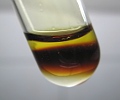

Chlorine dioxide, what is its color in solution?
It is well known that chlorine dioxide is a yellow gas with an intense color. This gas is soluble in water quite well and these solutions in water are said to have a deep yellow color as well. When chlorine dioxide is prepared, then usually this is done at very low pH with excess acid present in the solution. When such solutions are used, then indeed the solutions are deep yellow.
When just a small amount of acid is used, then chlorine dioxide seems to have a remarkably dark color in its solutions. The question even rises whether the dark compound really is chlorine dioxide. It may also be some adduct of chlorine dioxide.
![]()
![]() Required
chemicals:
Required
chemicals:
-
sodium chlorite
-
any strong acid (e.g. HCl, HNO3)
![]() Required
equipment:
Required
equipment:
-
test tubes
-
pasteur pipette + straw or pipette filler
![]() Safety:
Safety:
- Sodium chlorite is a strong oxidizer and forms dangerously sensitive mixes with many reductors.
- Chlorine dioxide is quite toxic. Avoid inhalation of the gas. It is not as choking and dangerous as chlorine gas, but still, inhaling large quantities of this gas may lead to serious damage of lungs and tissues in the respiratory tract.
- Chlorine dioxide is explosive. Bright light (sunshine!) may lead to violent explosions. Use gloves and eye protection! Never scale up the experiments as described on this web page.
- Do not use concentrated sulphuric acid in this experiment. Mixing a 30% solution of sodium chlorite with concentrated sulphuric acid leads to explosion!!
![]() Disposal:
Disposal:
- All involved chemicals are relatively non-toxic and if any solid waste remains, this may be wrapped in a piece of tissue paper and put in the household waste. All liquid waste may be flushed down the drain with a lot of water.
- Bleach should not be flushed into septic tanks, it kills the bacteria in the septic tank.
![]()
Procedure for performing the experiment with small amount of acid
![]() Prepare
an approximately 30% solution of sodium chlorite by dissolving 1 gram of sodium
chlorite in 2 ml of water. Do this in a test tube. The solution is colorless or
very pale yellow.
Prepare
an approximately 30% solution of sodium chlorite by dissolving 1 gram of sodium
chlorite in 2 ml of water. Do this in a test tube. The solution is colorless or
very pale yellow.
![]() Add a
small amount of dilute acid (3M HCl, 3M HNO3, or 2M H2SO4).
The amount of acid added must be less than 0.5 ml. Add the acid very carefully,
such that a layer of acid remains floating on the more dense solution of sodium
chlorite. This results in three layers of liquid. When the test tube is shaken
then the entire liquid becomes very dark brown. The two pictures below show the
result.
Add a
small amount of dilute acid (3M HCl, 3M HNO3, or 2M H2SO4).
The amount of acid added must be less than 0.5 ml. Add the acid very carefully,
such that a layer of acid remains floating on the more dense solution of sodium
chlorite. This results in three layers of liquid. When the test tube is shaken
then the entire liquid becomes very dark brown. The two pictures below show the
result.
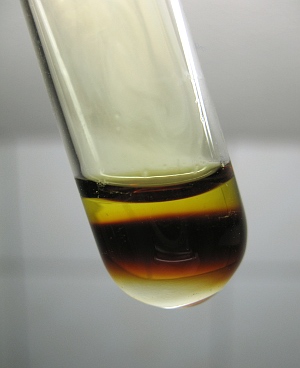
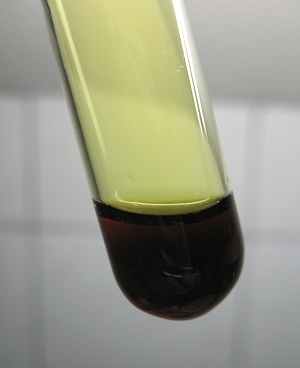
The left picture shows still nearly colorless solution of sodium chlorite at the bottom. The very dark layer is acid mixed with the solution of sodium chlorite. The top yellow layer is acid with some chlorine dioxide dissolved in it.
The right picture shows the result of shaking the test tube. This also shows that gas is released from the liquid. Above the liquid there is a clearly visible yellow color. Also noticeable is the white fume/smoke above the liquid. It is not clear what this is.
![]() Continue shaking the liquid and every time when a deep yellow
gas mix has built up above the liquid, blow away that gas and shake again. In
this way, a lot of chlorine dioxide is released from the dark liquid. Blowing
away can be done safely with the help of a glass pasteur pipette with its tip a
cm above the liquid surface and a pipette filler with which air is pushed into
the test tube. If no pipette filler is available you can use a long straw and
connect that to the pipette and blow gently with your mouth. The liquid itself
becomes lighter, due to loss of chlorine dioxide. The picture below shows the
result after three times shaking and blowing away the chlorine dioxide from
above the liquid.
Continue shaking the liquid and every time when a deep yellow
gas mix has built up above the liquid, blow away that gas and shake again. In
this way, a lot of chlorine dioxide is released from the dark liquid. Blowing
away can be done safely with the help of a glass pasteur pipette with its tip a
cm above the liquid surface and a pipette filler with which air is pushed into
the test tube. If no pipette filler is available you can use a long straw and
connect that to the pipette and blow gently with your mouth. The liquid itself
becomes lighter, due to loss of chlorine dioxide. The picture below shows the
result after three times shaking and blowing away the chlorine dioxide from
above the liquid.
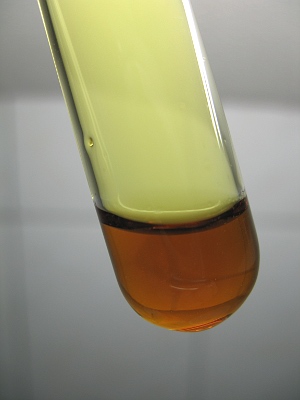
The liquid has become much lighter and the gas mix above the liquid contains quite a lot of white fume or smoke.
During this experiment no visible bubbles of gas are produced.
Performing the experiment with excess amount of acid
When a similar experiment is performed with excess acid, then the result is quite different. Again, take a small quantity of 30% solution of sodium chlorite and now add an equal volume of concentrated hydrochloric acid or 30% nitric acid.
When this is done, then the result is as follows:
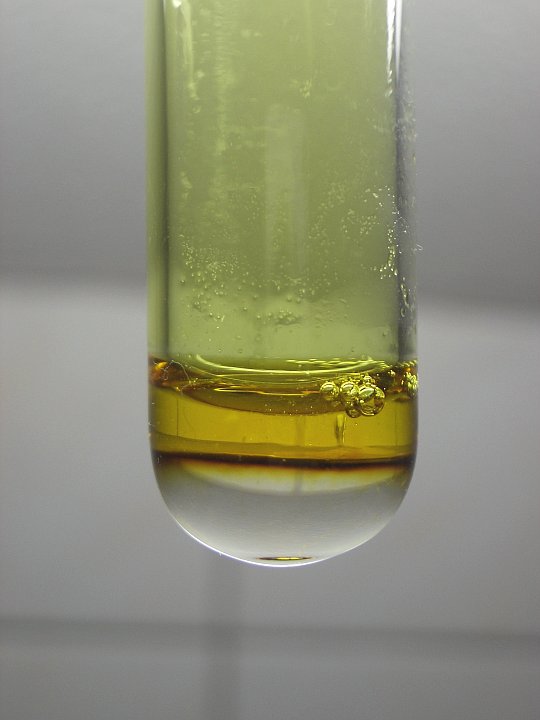
This picture show a top layer with a yellow color and there are visible bubbles of chlorine dioxide. The acid was poured on the solution of sodium chlorite very carefully and hence a very thin layer was formed, which again shows the dark color. Under the dark layer is the colorless solution of sodium chlorite.
When the liquid is viewed from above and, then one can see the true color of the dark layer. It is brown and is laying on the colorless solution of sodium chlorite like a disk.
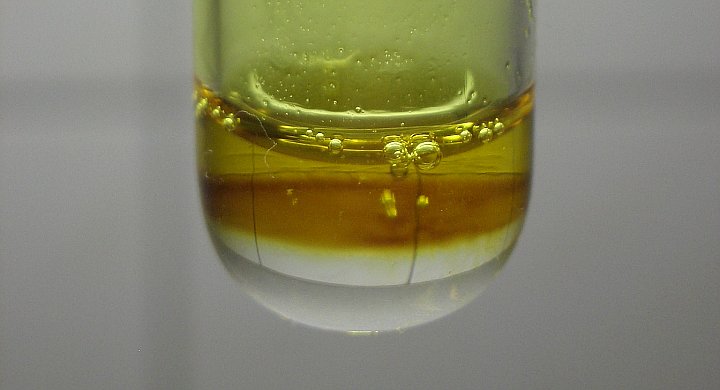
When the test tube with excess acid is shaken, then a yellow liquid is obtained, which produces bubbles of chlorine dioxide. Another noticeable difference is that the chlorine dioxide is much clearer in this experiment. There are no or hardly any white fumes.
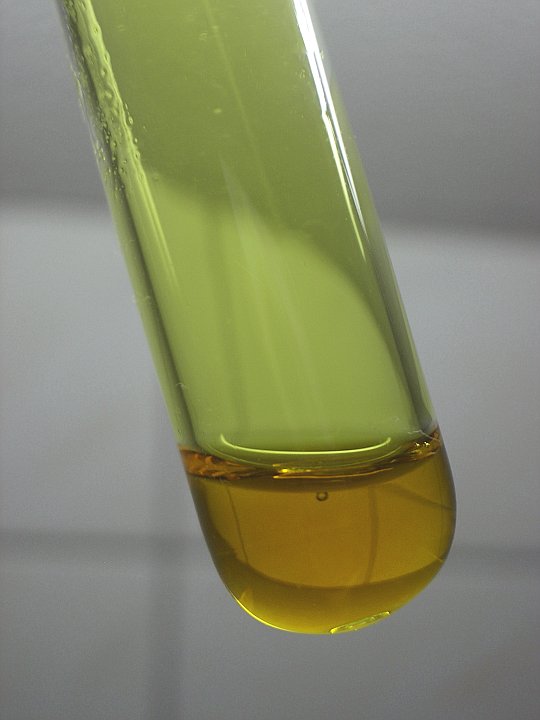
![]()
Discussion of results
![]() Chlorite ion is unstable in the presence of acid. It disproportionates to
chloride ion and chlorine dioxide:
Chlorite ion is unstable in the presence of acid. It disproportionates to
chloride ion and chlorine dioxide:
5ClO2– + 4H+ → 4ClO2 + 2H2O + Cl–
Chlorine dioxide is soluble in water and its solutions are said to be deep yellow. The deep yellow color indeed is produced when there is excess amount of acid. If there is just enough acid, or even a little less, then a very dark compound is produced, which remains in solution.
When this dark solution is exposed to air, then it looses chlorine dioxide and it becomes lighter. This is an indication that the dark compound is chlorine dioxide, but its very dark color indicates otherwise.
The precise nature of this dark compound is not known to me, it may indeed be simply chlorine dioxide, but is may also be some adduct. Remarkable thing is that this dark color depends on pH, at lower pH the intensity of the color is reduced.
Another remarkable thing is the formation of white fumes or smoke when chlorine dioxide is released from a liquid in which there is just a small amount of acid. In the presence of large excess amounts of acid the gas is clear.